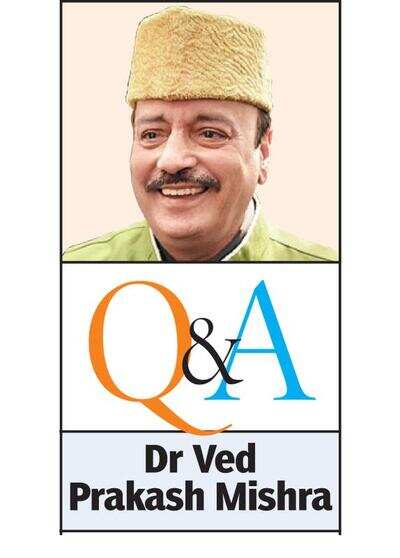
Dr Ved Prakash Mishra, a senior academic and committee member of Medical Council of India, headed a study task force in 1994-95 to look into inequity in medical education. Constituted by the Vidarbha Statutory Development Board (VDB), the study found that local students were missing out on admissions in medical colleges in Vidarbha and Marathwada. The state then came up with the 70:30 formula which was done away with on Tuesday. TOI speaks to Dr Mishra on the importance of the decision and the implications of its withdrawal now.
Excerpts ...
What were the conditions which led to the 70:30 formula being implemented?
It started with the formation of Vidarbha Statutory Development Board around 1994-95 as per provisions of the Constitution. Its premise was that in every region there are bound to be inequities in development and hence modalities need to be worked out to correct it. Following this, under my chairmanship a task force was constituted to look into inequity in medical education. After some months of research, it became clear that there was a glaring imbalance in the number of admissions done at medical colleges from their native region.
How did you reach that conclusion?
We divided the state into three zones — Vidarbha, Marathwada and rest of Maharashtra. This excluded Mumbai, Pune and Nashik where development was not an issue. In each zone we looked at first the number of medical colleges and number of seats available. Then we worked out the ratio of each seat to the population of that zone. Next was the ‘rate of eligibility’, which is how many students cleared their HSC under the local regional board. At that time, there were no entrance tests for medical seats. This gave us an idea of how many local students are eligible for admissions. Then we looked at number of students from native geographical region, finally getting admissions. All these computations gave us a clear picture on how many seats are going to those from ‘rest of Maharashtra’ vis-à-vis local students. And statistics showed that bulk of the seats were not going to native students.
Was this problem compounded as there were fewer seats back then?
In the mid-90s, there were roughly 650 seats in Vidarbha (currently it’s almost double). Some colleges like NKP Salve and the one at Sawangi had barely started a year or two prior. From these seats first you deduct the 15% all-India quota. Then there are seats fixed under reservation. So it was very tough for regional students to get into medical colleges while competing with those from Mumbai and Pune who had access to better facilities and quality of education.
Why 70:30, why not more or less?
The backlog of inequity cannot be cleared in one year. Also, you can’t reserve 100% seats too. So the Board, based on our report, proposed the 70:30 formula which would gradually increase till years of backlog is cleared. It will decrease too once its purpose is met.
But is it not good that merit triumphs rather than regional consideration?
The Constitution allows for reasonable restrictions to ensure equitable development. The quota was to make sure that students from remote Gadchiroli too stand a change of getting admission while competing with someone from Mumbai. I can’t race you if my legs are tied.
Did the regional quota achieve its goal?
Substantially. With 70% seats for native students, we have been able to produce more doctors from the region. But has it been effective to the extent that the formula is no more required, is subject to a scientific study. Because if implementation of the formula was backed by a scientific study, ideally removal should follow the same formula.
There are fears that this will lead to Mumbai and Pune students hogging majority of seats here.
At this stage I don’t want to comment on this till I go through some scientific study about position of merit students of various boards. If the numbers prove that the backlog has been cleared and 70:30 is no more required, I will gladly stand by it. My information is based on the data collected between 1991-94, following which I prepared the report that showed the inequity.
Excerpts ...
What were the conditions which led to the 70:30 formula being implemented?
It started with the formation of Vidarbha Statutory Development Board around 1994-95 as per provisions of the Constitution. Its premise was that in every region there are bound to be inequities in development and hence modalities need to be worked out to correct it. Following this, under my chairmanship a task force was constituted to look into inequity in medical education. After some months of research, it became clear that there was a glaring imbalance in the number of admissions done at medical colleges from their native region.
How did you reach that conclusion?
We divided the state into three zones — Vidarbha, Marathwada and rest of Maharashtra. This excluded Mumbai, Pune and Nashik where development was not an issue. In each zone we looked at first the number of medical colleges and number of seats available. Then we worked out the ratio of each seat to the population of that zone. Next was the ‘rate of eligibility’, which is how many students cleared their HSC under the local regional board. At that time, there were no entrance tests for medical seats. This gave us an idea of how many local students are eligible for admissions. Then we looked at number of students from native geographical region, finally getting admissions. All these computations gave us a clear picture on how many seats are going to those from ‘rest of Maharashtra’ vis-à-vis local students. And statistics showed that bulk of the seats were not going to native students.
Was this problem compounded as there were fewer seats back then?
In the mid-90s, there were roughly 650 seats in Vidarbha (currently it’s almost double). Some colleges like NKP Salve and the one at Sawangi had barely started a year or two prior. From these seats first you deduct the 15% all-India quota. Then there are seats fixed under reservation. So it was very tough for regional students to get into medical colleges while competing with those from Mumbai and Pune who had access to better facilities and quality of education.
Why 70:30, why not more or less?
The backlog of inequity cannot be cleared in one year. Also, you can’t reserve 100% seats too. So the Board, based on our report, proposed the 70:30 formula which would gradually increase till years of backlog is cleared. It will decrease too once its purpose is met.
But is it not good that merit triumphs rather than regional consideration?
The Constitution allows for reasonable restrictions to ensure equitable development. The quota was to make sure that students from remote Gadchiroli too stand a change of getting admission while competing with someone from Mumbai. I can’t race you if my legs are tied.
Did the regional quota achieve its goal?
Substantially. With 70% seats for native students, we have been able to produce more doctors from the region. But has it been effective to the extent that the formula is no more required, is subject to a scientific study. Because if implementation of the formula was backed by a scientific study, ideally removal should follow the same formula.
There are fears that this will lead to Mumbai and Pune students hogging majority of seats here.
At this stage I don’t want to comment on this till I go through some scientific study about position of merit students of various boards. If the numbers prove that the backlog has been cleared and 70:30 is no more required, I will gladly stand by it. My information is based on the data collected between 1991-94, following which I prepared the report that showed the inequity.

Coronavirus outbreak
Trending Topics
LATEST VIDEOS
City
 ‘Will expose you': Kangana Ranaut slams Uddhav Thackeray and Karan Johar 'gang' after BMC razes her office
‘Will expose you': Kangana Ranaut slams Uddhav Thackeray and Karan Johar 'gang' after BMC razes her office  Kangana vs Sena: Battle between demolishing house and demolishing ego
Kangana vs Sena: Battle between demolishing house and demolishing ego  Two Pakistani smugglers gunned down by BSF near Rajasthan border; pistols, drugs recovered from site
Two Pakistani smugglers gunned down by BSF near Rajasthan border; pistols, drugs recovered from site  Was BMC in a hurry to demolish Kangana Ranaut's home?
Was BMC in a hurry to demolish Kangana Ranaut's home?
More from TOI
Navbharat Times
Featured Today in Travel
Quick Links
Kerala Coronavirus Helpline NumberHaryana Coronavirus Helpline NumberUP Coronavirus Helpline NumberBareilly NewsBhopal NewsCoronavirus in DelhiCoronavirus in HyderabadCoronavirus in IndiaCoronavirus symptomsCoronavirusRajasthan Coronavirus Helpline NumberAditya ThackerayShiv SenaFire in MumbaiAP Coronavirus Helpline NumberArvind KejriwalJammu Kashmir Coronavirus Helpline NumberSrinagar encounter
Get the app



